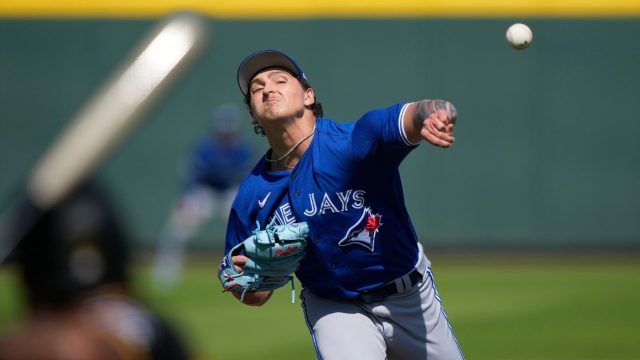
BOSTON — The closest Davis Schneider came to walking away from baseball was June, 2021.
He was 22 and playing only once a week with high-A Vancouver — not enough time to find a rhythm at the plate, yet just enough time to refresh his despondency with another 0-for-3. Halfway through the season, he had five hits in 52 plate appearances.
“I was batting .100 in June,” Schneider says. “I just didn’t think there was a future left.”
One night, Schneider texted a former teammate he’d played with in 2018 and ’19, Dom Abbadessa, who the Blue Jays released following the lost 2020 minor-league season. Schneider told Abbadessa he wanted to quit.
“He texted me back, and he was like, ‘Just keep going with it. Because if I was still there, I would never want to give it up ever again,’” Schneider remembers. “That helped me stick with it and push through. And just take the chance. Even if it’s a small one. Just go for it.”
Friday, only two years after that text exchange, at Fenway Park, a ballpark he’d never set foot in before, where Williams and Yastrzemski and Ortiz played, against a division rival in the thick of a playoff race, facing a guy with 150 starts and a no-hitter in the bigs, as his parents, his family, his friends from back home in Berlin, N.J. looked on, Schneider stepped into the box for his first major-league plate appearance:
That was the third home run the Blue Jays hit off Red Sox starter James Paxton in the game’s first seven batters. It was an unforgettable moment on a night that saw Toronto finally, at long last, earn their first victory against Boston in eight attempts this season, by a final score of 7-3. The home run was part of a 14-hit, five-homer barrage that saw the club score more than four runs for the first time in a week and yet somehow, almost comically, still manage to go 0-for-7 with runners in scoring position.
It was high art if you’ve ever seen it, and that was before Schneider came to the plate in the seventh, skipped a weak grounder to the second baseman, and beat the damn thing out. When he’s doing stuff like that, are you at all surprised this 28th-round pick has found a way to force himself to the majors?
“He’s the typical minor-league success story,” said John Schneider, the Blue Jays manager of no relation. “Just a dude that’s really taken advantage of every opportunity, every resource that’s given to him. … He doesn’t take things for granted. He’s just worked his ass off to get to this point. And he’s going to continue to do the same thing.”
The 849th pick in the 2017 draft, Davis Schneider has spent time at each North American minor-league stop in the Blue Jays organization, including one — the Appalachian League’s Bluefield Blue Jays — that doesn’t even exist anymore. He’s been pushing his boulder uphill for so long that the round he was drafted in no longer exists, either. He’s amassed over 1,600 plate appearances along the way, batting .253/.373/.463 while playing every position on the field save for centre field and catcher.
He’s made incremental improvements at each stop, quickly becoming a favourite of Blue Jays development staff for how eagerly he bought into the tools and instruction they provided him. And it all came together at triple-A this season, where he cut his strikeout rate to the lowest it’s been since a 50-game rookie ball stint when he was 18 and flashed new-found power with 21 home runs. The most he’d hit at a single level prior was nine with the Vancouver Canadians in 2021.
Schneider credits some of that to bulking up over the years, and some of it to ditching a pre-pitch leg kick in favour of a toe tap. The right-handed hitter is an admitted tinkerer. There are seasons in his career when his swing was changing month-to-month, week-to-week, and sometimes game-to-game. But this year he finally decided to pick one mechanic and stick with it.
“It definitely helped me tap into my power. Although, I didn’t mean to do that. It was more of a timing mechanism,” Schneider says. “The power aspect just came with it.”
One way or another, it’s helped Schneider run a 44 per cent hard-hit rate and 89.8-m.p.h. average exit velocity at triple-A this season, barrelling some balls as high as 108 and 109. A doggedly disciplined plate approach helps, too. Schneider has posted a 20.7 per cent chase rate this season while walking in nearly a fifth of his plate appearances.
That selectivity comes from Schneider’s desire to only swing at pitches he can drive. Before a game, he learns the opposing starter’s repertoire and then steps to the plate looking for the pitch he thinks they’re most likely to throw in a good spot for his swing.
That’s typically a fastball. Schneider knows he isn’t the kind of hitter who’s going to flip an early-count off-speed pitch over the second baseman’s head. He’s the kind of hitter who’s going to take those pitches, even if they put him behind in the count, and look for something firm in the middle of the zone that he can barrel.
“I just know what pitches I can hit and what I can handle,” Schneider says. “I know I’m not the biggest guy or the best power hitter. But I believe I have a good eye at the plate. I’m patient. And I know what I can do.”
He certainly isn’t the biggest guy, which has worked in Schneider’s favour at triple-A where baseball’s automated strike zone is being trialled this season. Listed at five-foot-nine, Schneider’s zone is considerably smaller than the average ballplayer’s. And he’s learned quickly how to discern between pitches up and down that the ABS system will judge as balls and strikes. He swung at only 39.7 per cent of the pitches he saw at triple-A this year, an 11th percentile mark.
It also must be said that triple-A baseball has been a wildly inflated offensive environment this season. International League teams are averaging 5.6 runs per game in 2023 (Pacific Coast League clubs are averaging an insane 6.2). MLB’s average, meanwhile, is a full run lower at 4.6. Currently, there are 16 qualified hitters in the International League batting over .300. Last season, there were only five. And in 2021, just four.
And yet, Schneider’s 140 wRC+ still ranks sixth in the International League and his .969 OPS sits ninth. Those numbers are impressive regardless of the environment. And much of Schneider’s production is fuelled by his swing decisions — he leads the International League in walks with 72 — which ought to be transferrable up a level.
“He has a good understanding of the strike zone,” John Schneider, the manager, says. “I think it’s a good time to inject that type of approach into our offence. He’s going to work pitchers. He’s going to not be in a rush to make things happen. He’s going to wait for his pitch.”
Davis Schneider’s deployment will be interesting to follow, as he’s run fairly pronounced reverse splits this season, with a 1.070 OPS vs. right-handed pitching and .748 against lefties. He has only 11 extra-base hits against lefties this season and 17 of his 21 homers have come when facing right-handers.
John Schneider said Davis Schneider would see most of his opportunities against left-handed pitching going forward, but that he could also be playable against right-handers his swing matches up well with. He’ll also be a key weapon off the bench late in games when the Blue Jays need a patient, pinch-hit plate appearance.
Meanwhile, the Blue Jays weren’t about to throw Schneider out in front of the Green Monster — either Schneider; but Davis, specifically — in his first major-league game, but he’s playable in left field as well as second base. For his part, Schneider arrived in Boston with three gloves — an infield one, an outfield one, and a first baseman’s mitt. He’s ready for any assignment he gets.
Which is how he got here in the first place. By forcing his way through every opening. By beating out groundballs to second basemen. As an ultra-late round pick, Schneider’s had to scrap for the opportunities more highly-touted prospects are handed. Two years ago in Vancouver, they’d only let him play once a week. Now, he’s hitting bombs at Fenway Park. All he’s ever asked for was a shot.
“Before I got drafted, I always said, ‘I just want one opportunity,’” Schneider says. “If it was the first round or the 28th round — I just wanted to run with it. I believe in myself to where if I just put my foot in the door, I think I have a chance. Just work hard and good things will happen.”







